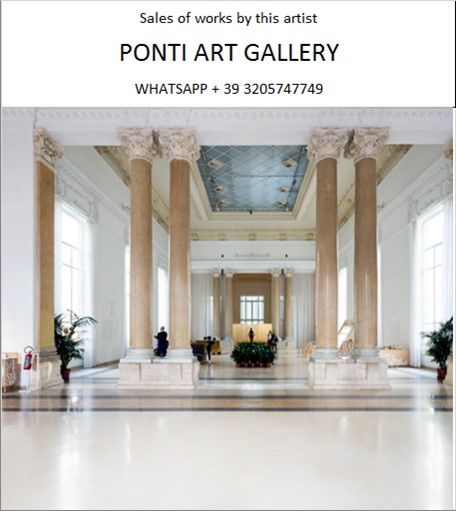Ponti Art Gallery is interested in buying and selling works
of art by this artist.

Hermann Nitsch Biography
Hermann Nitsch was an Austrian avant-garde artist whose multifaceted work spanned performance, painting, composition, and set design. Born on August 29, 1938, in Vienna, Nitsch's early life was marked by the tumult of World War II, an experience that profoundly influenced his later work. He grew up witnessing bombing raids and suffered the loss of his father in Russia. These early experiences shaped his worldview, turning him into a cosmopolite and an opponent of nationalism and politics from a young age.
Nitsch's education began at the Higher Graphical Federal Education and Research Institute in Vienna, where he honed his talent for drawing. Despite his initial lack of interest in formal schooling, which led to his departure from grammar school, his artistic abilities allowed him to enroll at the graphic arts college, providing him with a solid foundation in the arts. His studies ranged from nature to abstract painting, and he developed a keen interest in literature, theater, and classical music.
In the late 1950s, Nitsch became a graphic artist at the Technical Museum in Vienna, which also provided him with a large studio space. It was during this time that he began to work on the scores of the Orgien Mysterien Theater (Theatre of Orgies and Mysteries), an ambitious project that sought to create a total work of art encompassing various disciplines and sensory experiences.
Nitsch's artistic journey took a significant turn in 1961 when he met fellow artists Otto Muehl, Günter Brus, and Rudolf Schwarzkogler. Together, they were known as the Viennese Actionists, a group that explored performative art as a means of expression. Their work was often controversial and provocative, challenging societal norms and the boundaries of traditional art forms.
Throughout the 1960s and 1970s, Nitsch's work became synonymous with Viennese Actionism. He staged radical and confrontational performances that involved the use of animal carcasses, blood, and other organic materials, seeking to engage all five senses of the audience. These performances were not without controversy, and Nitsch faced several legal challenges, including arrests and trials for public indecency.
Despite these challenges, Nitsch's work gained international recognition. He participated in the 'Destruction in Art' festival in London in 1966, where his action was enthusiastically received but also cut short by the police. The event organizers faced legal repercussions, and Nitsch's personal life was also affected, leading to his divorce from his first wife, Eva.
Tragedy struck again in 1977 when Nitsch's second wife, Beate, was killed in an accident. This event plunged him into deep grief and led to a period of intense self-reflection and questioning. However, he continued to create and perform, and in the same year, he staged an action in Bologna as a requiem for Beate.
In 1971, Nitsch acquired Prinzendorf Castle in Lower Austria, which became a central location for his work and the realization of his Orgien Mysterien Theater. The castle provided a venue for large-scale performances that incorporated noise orchestras, scream choirs, and electronically amplified instruments.
Nitsch's work often drew from religious themes and rituals, exploring the essence of human existence and passion. He saw the painting process as a condensed form of life and passion, with the artist's presence in the work inviting viewers to engage with the creative process.
Over the years, Nitsch's art has been honored with numerous exhibitions and retrospectives, including major shows at the Essl Museum, the Martin Gropius Bau in Berlin, and the Albertina in Vienna. His work is included in prestigious collections worldwide, such as the Museum of Modern Art and the Guggenheim Museum in New York, the Centre Georges Pompidou in Paris, and the Tate Gallery in London.
Nitsch continued to innovate and create until his passing on April 18, 2022, at the age of 83. His legacy lives on through his groundbreaking contributions to the art world, his influence on subsequent generations of artists, and the permanent exhibitions of his work at the Nitsch Museums in Mistelbach and Naples, as well as the Nitsch Foundation in Vienna.
Related
tell me more
what was hermann nitsch's most famous work
how did hermann nitsch's art influence the avant-garde scene in vienna
what was the controversy surrounding hermann nitsch's art
Hermann Nitsch - Wikipedia
Hermann Nitsch | Pace Gallery
Biography - Nitsch Foundation
avant-garde artist hermann nitsch, known for his works of flesh ...
Hermann Nitsch. Farbe als Material - Nitsch Foundation
View More
Hermann Nitsch Quotes and
Sales of Works
Ponti Art Gallery selects and deals with paintings by the
artist. Upon request, we provide free estimates and
evaluations, communicate prices, quotations, and current
market values.
If you are interested in BUYING or SELLING works by the
artist, contact us immediately.
If you wish to sell or receive an evaluation of the
works:
Send us a frontal photo of the painting, one of the back,
and one of the signature. Also, indicate the dimensions of
the work. Inform us about the purchase origin of the work
and any kind of available documentation (purchase
receipts, certificates of authenticity, publications). One
of our operators will respond to you on the same day. We
guarantee maximum confidentiality and extreme
professionalism.
If you wish to purchase works by the painter: Contact us
and let us know your request. We will inform you about the
available works. We also offer the possibility to
subscribe to our NEWSLETTER, through which you will be
informed at the beginning of each month about the latest
acquisitions of the art gallery.
You can send us pictures of the work:
